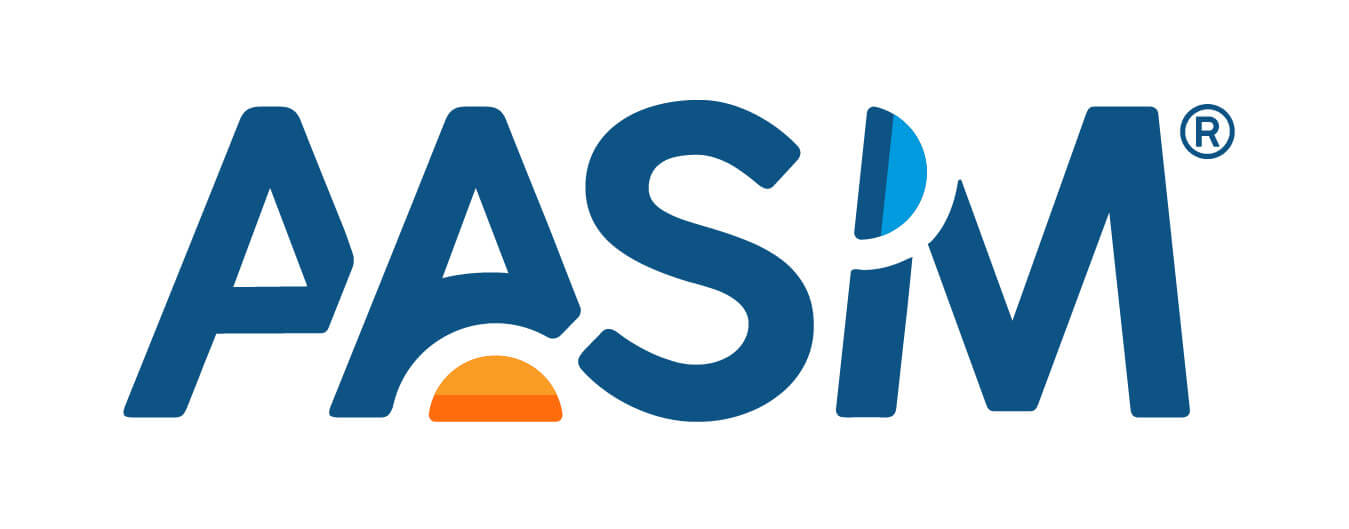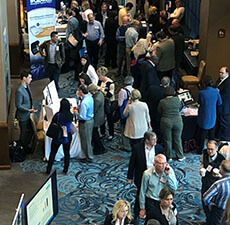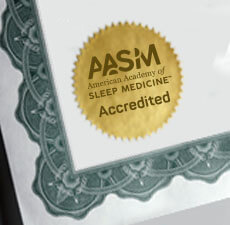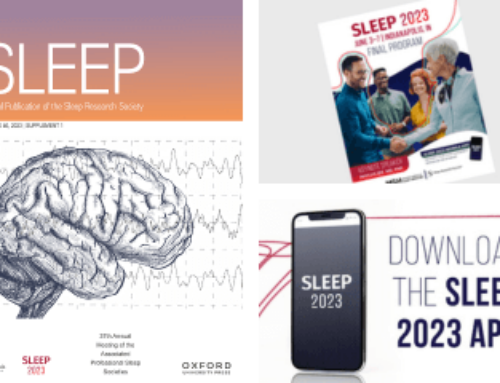More than 5,500 sleep medicine physicians, sleep researchers, sleep technologists and others involved in the sleep field gathered in Baltimore June 9-12, 2008, for the 22nd annual meeting of the Associated Professional Sleep Societies.
SLEEP 2008 commenced Monday morning with a plenary session that included an awards ceremony, a presentation and a keynote address.
After APSS Program Committee Chair Dr. Michael Vitiello opened the plenary session, American Academy of Sleep Medicine President Dr. Alex Chediak followed with a presentation of the 2008 AASM Awards. The Nathaniel Kleitman Distinguished Service Award went to Dr. Conrad Iber of the University of Minnesota for his many contributions to the AASM, most notably serving as the chair for the
AASM Manual for the Scoring of Sleep and Associated Events.
For the next presentation, Dr. Chediak deferred to Dr. William Dement, namesake of the William C. Dement Academic Achievement Award. Dement presented the award to his friend and colleague Dr. Terry Young of the University of Wisconsin-Madison for her work on the landmark Wisconsin Sleep Cohort Study.
Dr. Chediak then presented the Mark O. Hatfield Public Policy Award to Dr. Neil Kavey of Columbia University, longtime president of the New York State Society of Sleep Medicine.
Following the awards ceremonies was a presentation by Dr. James Kiley, Director of the Division of Lung Diseases in the National Heart, Lung, and Blood Institute within the National Institutes of Health, on the 2008 NHLBI strategic plan.
Dr. Hobson concluded the plenary session with an intriguing keynote address on “Sleep, Dreaming and Consciousness – A New Paradigm.”
In her address, Dr. Esther outlined her goal for her tenure: ensuring balance. Embracing the diversity of the membership and their professional interests, Dr. Esther reaffirmed the AASM’s commitment to academic sleep medicine, clinical practice and research, and stressed her goals of working closely with the Centers for Medicare & Medicaid Services and independent carriers on policies as well as promoting the sleep medicine physician. You can read a full version of Dr. Esther’s remarks on the AASM Web site at
https://aasm.org/president-talks-from-sleep-2008
The Board of Directors for 2008-2009 was installed at the meeting. Joining Dr. Esther and Past President Dr. Chediak are President-elect Dr. Clete Kushida and Secretary/Treasurer Dr. Nancy Collop. New Directors commencing their three-year tenure are Drs. Sam Fleishman and Safwan Badr.
Dr. Chediak recognized two members of the Board of Directors who completed their terms of service: Drs. Richard Berry and Art Spielman. Both Drs. Berry and Spielman contributed greatly to the board and the organization during their tenures.
At the Membership Meeting the accomplishments of sleep medicine scientists were noted with the presentation of the Young Investigator Award. Dr. Ehab Dayyay of the University of Louisville received the award this year for his abstract “Peripheral recruitment of marrow-derived very small embryonic-like stem cells following intermittent hypoxia during sleep.”
The following members were recognized with the Young Investigator Honorable Mention: Dr. Fawad Mian of New York University; Daniel Kay of the University of Florida; Dr. Nabil Al Lawati of the University of British Columbia; and Dr. Tracy Rupp of the Walter Reed Army Institute of Research.
At SLEEP 2008 the AASM launched an initiative to help members and accredited centers across the country establish and incorporate state sleep societies. The Tuesday morning session provided attendees with information they need to organize at a local level and to run an effective state society. If you missed the session and are interested in learning more about organizing a state sleep society, contact Ted Thurn at (708) 492-0930 or
tthurn@aasm.org.
A separate session held Tuesday morning was a forum for members to discuss local regulatory policies and legislation as well as on-going initiatives in state government. More information about health policy, at the national and local levels, is on the AASM’s Web site:
https://aasm.org/advocacy/.
Dr. Esther on Tuesday afternoon chaired Home Sleep Testing CMS NCD 240.4 vs. AASM Clinical Guidelines for the Use of Unattended Portable Monitoring. The workshop included a presentation on the AASM Clinical Guidelines for Unattended Portable Monitoring by Secretary/Treasurer Dr. Collop; an overview of CMS NCD 240.4 by Past President Dr. Chediak and of local coverage determination (LCD) policies by Executive Director Jerry Barrett; and discussion of the impact of the decision on hospital-based sleep centers and freestanding sleep centers by Directors Drs. Fleishman and Lawrence Epstein. Members are encouraged to visit
https://aasm.org/advocacy/position-statements/ for comprehensive information on portable monitoring, including current LCD policies.
AASM Membership Sections met throughout the week to introduce the section, form the Steering Committee, suggest topics for the scientific program of the SLEEP annual meeting, discuss initiatives of the respective sections and recognize the recipient of the Membership Section Award.
This year, attendees submitting an abstract for presentation at SLEEP had the opportunity to submit their research for consideration for a Membership Section Award. A steering committee for each Membership Section reviewed the submitted abstracts and selected one to recognize for its significance and contribution to sleep medicine. Following is a list of the 2008 recipients:
Insomnia Section – Dr. Jennifer Martin
“Self-reported Sleep Quality Predicts Mortality Within One Year of Post-Acute Rehabilitation Among Older People”
Sleep-Related Breathing Disorders Section – Dr. Nabil Al Lawati
“Occupational Injuries in Patients with Obstructive Sleep Apnea”
Childhood Sleep Disorders & Development Section – Dr. Denys Volgin
“Perinatal Alcohol Exposure Leads to Long-lasting Overexpression of GABA(A) Receptors in the Rat Posterior Hypothalamus and Increases Behavioral Sensitivity to Gaboxadol”
Circadian Rhythms Section – Dr. Kun Hu
“Influences of Postural Tilt Stress and the Circadian System on Cardiovascular Risk Factors”
Sleep Deprivation Section – Christopher Jung, MS
“Influence of Sleep Deprivation and Recovery Sleep on 24 Hour Energy Expenditure”
Two days of postgraduate courses marked the beginning of the scientific program. This year’s diverse and robust program included 17 symposia, 4 discussion groups, 7 clinical workshops, 18 meet-the-professor lunch sessions, 8 invited lecturers, 36 brief oral presentation sessions and more than 900 poster presentations. Download the final program from
www.sleepmeeting.org for a full listing of events.
The invited lecturers at SLEEP 2008 were among the most notable names in the field. On Monday Dr. Ronald Grunstein presented “Managing Sleep Apnea – Are We There Yet?” and Dr. Ronald Szymusiak lectured on “Hypothalamic Regulation of Sleep Onset and Sleep Maintenance.” Tuesday’s lecturers included Dr. Charles Czeisler’s talk “Sleep and Circadian Rhythms in Humans: Tales of Translation from the Lab to Practice” and “Treating Insomnia with CBT: Should We Step Up to Stepped Care?” by Dr. Colin Espie. Dr. Christopher Early discussed “Restless Legs Syndrome: From the Bed to Bench and Back Again” on Wednesday while Dr. Terri Weaver gave her humorously-titled lecture “Not Tonight Honey! The Effect of Sleepiness on Daily (or Nightly!) Functioning.” The lectures were among the well-attended sessions at SLEEP 2008.
This year 159 companies displayed the latest products, goods and services available for the sleep field. The exhibit hall, which was the largest to-date, enabled attendees to learn more about the latest therapies available for sleep disorders, get first-hand demonstrations of products and interact with sales staff. The exhibitors also introduced new trends and offered a glimpse of future trends for the field. Special thanks are extended to all companies that exhibited at SLEEP 2008.
On Sunday, June 8, 2008, the American Sleep Medicine Foundation co-hosted the Discovering the Secrets of Sleep dinner. The evening featured an awards ceremony and entertainment by a local acting troupe, and afforded attendees an opportunity to connect with colleagues and friends.
The dinner marked the beginning for a new chapter for the ASMF. This year the structure of the ASMF changed, with an Executive Board responsible for reviewing grant applications, developing new research opportunities and creating new fundraising initiatives. Under the direction of its President Dr. Richard Berry, the ASMF has flourished this year.
Dr. Berry reported on the unparalleled support the foundation has received from the AASM. The AASM continues to cover all of the overhead and administrative expenses associated with running the foundation and in 2007 pledged an additional $2 million to the foundation for the development of new grant programs and initiatives. Dr. Berry discussed the first of these new endeavors, the AASM Physician Scientist Training Award, which is an investment in the leaders who will shape the future of the sleep field. Five one-year grants in the amount of $75,000 each will be awarded for the next five years – for a total of 25 AASM Physician Sleep Scientist Awards – to fellows at ACGME-accredited sleep medicine fellowship programs for one year of dedicated research in sleep medicine.
The first four recipients of the AASM Physician Scientist Training Award were announced at the dinner. One of these four grants was funded in-part through a $60,000 grant from Takeda Pharmaceuticals North America for an additional sleep research year for graduates of ACGME-accredited sleep medicine fellowships. Following is a list of recipients:
Dr. Josna Adusumilli
Brigham and Women’s Hospital
“Effectiveness of Night Floats and Naps in reducing the risks of interns’ 24+ hour shifts”
(award sponsored in-part by Takeda)
Dr. Ina Djonlagic
Brigham and Women’s Hospital
“Sleep, Learning and Parkinson Disease”
Dr. Mikhail B. Litinski
Brigham and Women’s Hospital
“Modulating Effect of Circadian Rhythm and Sleep/Wake Cycle on Severity of Sleep Apnea Hypopnea Syndrome”
Dr. Dennis Hwang
NYU School of Medicine/Division of Pulmonary and Sleep Medicine
“A Pilot Study Evaluating Changes in Pcrit after Therapy for OSA with Oral Appliance Therapy and Upper Airway”
According to Dr. Berry, this year the ASMF will introduce a new grant opportunity for 2009, thanks to a generous donation of $2 million from the American Board of Sleep Medicine for the creation of an endowment that will fund future grant opportunities. The first of these opportunities is the new American Board of Sleep Medicine Junior Faculty Research Award, which will assist new faculty in the development of a career in academic sleep medicine. Beginning in 2009 the American Sleep Medicine Foundation will award a two-year, $50,000 grant to one applicant per year. This award is only the beginning of a long-term, multi-faceted grant program that will be funded by this endowment. More information will be online shortly at
www.discoversleep.org
The science presented at SLEEP 2008 was featured prominently in the news, with coverage from major outlets such as Washington Post, Los Angeles Times, ABC news, NBC news, WebMD, Reuters Health, Prevention and NPR’s Science Friday.
Next year SLEEP 2009 will be held June 6-11 in Seattle, Washington, with AASM Past President Dr. Michael Sateia serving as Chair of the APSS Program Committee. Check
www.sleepmeeting.org throughout the year for updates on SLEEP 2009.







